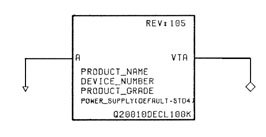Logic Design for Array-Based Circuits
by Donnamaie E. White
Copyright © 1996, 2001, 2002, 2008, 2016 Donnamaie E. White , WhitePubs Enterprises, Inc.
- Table of Contents
- Preface
- Overview
- Chapter 1 Introduction
- Chapter 2 Structured
Design Methodology
- Chapter 3 Sizing the
Design
- Functional Specification - A Closer Look
- Review the Available Arrays
- Architectual Specification or Hardware Specification
- Array Sizing
- Cell Capabilities
- Array Architecture
- Netlist
- Example: AMCC Interface Options
- Example - AMCC Arrays - Power Supply Options
- Interface Cell Functionality
- Examples
- Internal Cell Functionality
- Multi-Cell Macros
- Hard and soft macros
- Refining Interface Requirements
- Adding Extra Power and Ground Macros
- Dual-Function I/O Macros
- Example - Simultaneously Switching Outputs
- Thermal Diodes
- The AMCC Speed Monitor
- Final Interface Cell Utilization
- Drivers
- Exercises
- Chapter 3 Appendix = Case Study in Sizing a Design
- Chapter 4 Design Optimization
- Chapter 5 Timing Analysis for Arrays
- Chapter 6 External Set-up and Hold Times
- Chapter 7 Power Considerations
- Case Study: DC Power Computation
- Case Study: AC Power Computation
- Chapter 8 Simulation
- Case Study: Simulationest
- Chapter 9 Faults and Fault Detectiond Output
- Chapter 10 Design Submission
- ASIC Glossary
Sizing the Design - Selecting the Array
Example - AMCC Arrays - Power Supply Options
The power-supply and interface type matrix for the AMCC arrays shows a very flex ible approach to solving interface problems. Many of the AMCC arrays can be used with a single power supply (+5V) or dual supplies (+5V/-5.2V or +5V/-4.5V) as shown in Table 3-15.
The Q5000 and Q20000 Series arrays are bipolar arrays. They use an internal ECL core (0.5V ECL) and can externally interface to either Schottky TTL, ECL 10K or to ECL 100K. AMCC arrays allow for the mixed mode operation of ECL/TTL on the same array, either ECL 10K/TTL or ECL 100K/TTL or all three. Only one type of ECL may be used for input on a single array. Both ECL types may be used for output on the same array.
Table 3-15 AMCC Power Supply Options
| SINGLE | POWER | SUPPLY | DUAL POWER | SUPPLY | |
|---|---|---|---|---|---|
| I/O MODE | +5V | -5.2V | -4.5V | +5V/-5.2V | +5V/-4.5V |
| 100% TTL | x | ||||
| 100% ECL 10K | x | x | x | x | x |
| 100% ECL 100K | x | x | x | x | x |
| ECL10K/TTL | x | x | x | ||
| ECL100K/TTL | x | x | x |
100% ECL run with dual power supplies is called "DECL".
Table 3-15, with the exception of "DECL", also applies to the Q24000 Series BiCMOS arrays. They have a CMOS core and bipolar I/O and they can interface to CMOS.
The concept of mixed ECL-TTL interface on a single array was originated as a result of customer demand. The idea of operating ECL 10K at ECL 100K power supplies and visa versa was also the result of customer requests.
Example - Communicating to the Software
AMCC uses (used) dummy macros called chip macros that allow a user to specify precisely what array is to be used in what interface mode with what power supplies. (See Figure 3-4.) The chip macro communicates parameters to the AMCC MacroMatrix software modules that are performing design validation, including population and cell type limit checks. The array-specific checks use chip macro parameters to set limits for TTL outputs, Darlington outputs, simultaneously switching outputs, bidirectional macro counts, and other checks.
The AMCCERC software can spot mismatched interface macros and exceeded macro type limits and issue appropriate error messages. It can also adjust the DC power module to use the correct power supply in the power computation.
Figure 3-4 A Chip Macro (1994)

Macro libraries today carry a much richer set of parametric data designed to work with a larger number of EDA tool sets. They no longer require this "jury rigged" approach to feeding parametric data to the software. Each maco carries its own parametric data.
Copyright © 1996, 2001, 2002, 2008, 2016 Donnamaie E. White , WhitePubs
Enterprises, Inc.
For problems or questions on these pages, contact [email protected]